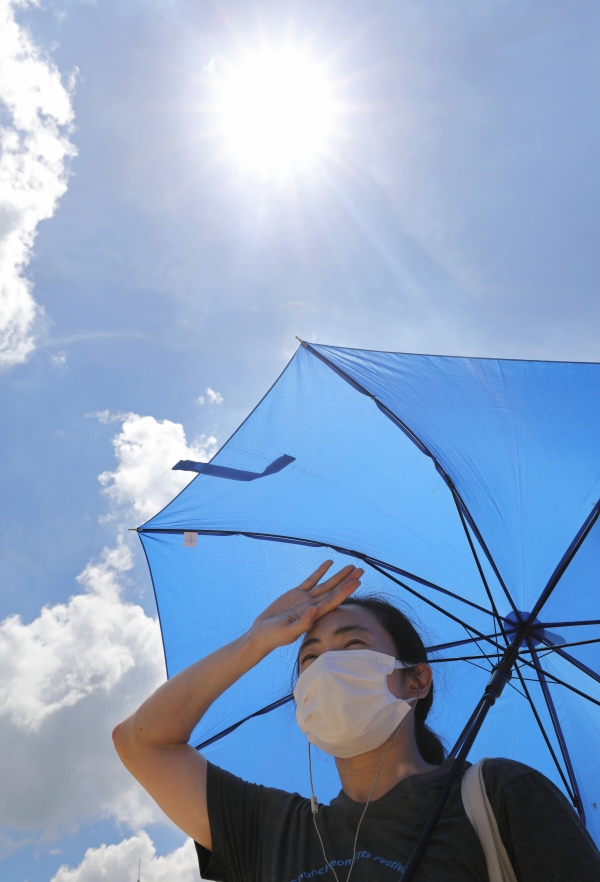
▲ On the morning of August 21 last year, when a heat wave warning was issued in Seoul and the metropolitan area, citizens are distorted by the heat of the torch installed at the Peace Gate of Olympic Park in Songpa-gu, Seoul. (Newsis)
Over the past two days, summer has suddenly arrived. On the 19th, the daytime temperature rose to around 30 degrees, centering on the central region, and the weather reminiscent of summer continued. Gangwon Yeongwol recorded 30 degrees, Seoul 28.4 degrees, and Suwon 28.2 degrees, recording the second highest temperature ever in mid-April. The day before (18th), the daytime temperature was cool with less than 20 degrees, but it rose by about 10 degrees in one day.
It is analyzed that the early heat came as the low pressure that used to rain quickly retreated and Korea entered the high pressure zone. As the heat continued on the 20th, many people took off their outerwear.
Around the same time, heatwaves exceeding 40 degrees were observed in various parts of Asia. According to AFP and the British daily Guardian on the 19th (local time), the temperature in Takju, western Thailand, on the 15th of this month was recorded at 45.4 degrees, the highest ever. Luang Prabang, a famous tourist destination in Laos, recently recorded the highest temperature in April since meteorological observations, with the temperature rising to 42.7 degrees Celsius. In Bangladesh, as the temperature exceeded 40 degrees for the first time in 58 years, asphalt roads in various parts of the capital, Dhaka, were captured. In Maharashtra, India, at least 13 people have died from heat stroke after hundreds of thousands of people gathered at an outdoor event in the intense sun.
There is a prospect that such a record-breaking heat wave may land in Korea as well. The Korea Meteorological Administration is predicting that some areas in Korea this year will experience an unprecedented heat wave exceeding 40 degrees.

▲On the afternoon of July 1 last year, when the heavy rain stopped and a heat wave warning was issued throughout Seoul, a citizen is covering the sun with a parasol near Seoul Plaza in Jung-gu, Seoul. (Newsis)
Heat waves appear every year with modifiers such as ‘the best ever’ and ‘worst’.
In 1994, when the heat wave was severe, more than 3,000 people died in Korea. At that time, Seoul (38.4 degrees), Daejeon (37.7 degrees) and Gwangju (38.5 degrees) broke the record for the daytime temperature, and in the case of Daegu, the daytime temperature soared to 39.4 degrees Celsius. The heat wave lasted for 33 days. About 1,000 people are said to have died in Seoul alone.
In 2016 and 2018, the heatwave also increased in momentum. At that time, the Tibetan high pressure center was located in the upper layer of the Korean atmosphere, and the North Pacific high pressure center was located in the lower layer, forming a ‘heat dome’. The conditions are set for the worst heatwave to take place.
In 2016, a heat wave warning was issued from May, and from the end of July to August, the temperature rose significantly and continued, resulting in heat waves (22.4 days) and tropical nights (10.8 days). In particular, the annual average temperature recorded 13.4 degrees, the highest since observation. It was a year in which not only heat waves and tropical nights, but also typhoons, heavy rains, and cold waves occurred. 2016 was also recorded as the hottest year in the world.
2018 was the hottest year in Korea. On August 1 of that year, the highest temperature in Seoul soared to 39.6 degrees Celsius. Hongcheon-gun, Gangwon-do recorded a whopping 41 degrees. The temperature in Hongcheon exceeded 40 degrees recorded in 1942, breaking the record for the highest temperature since 1907, when Korea began meteorological observation. In addition to Hongcheon, Gangwon-do Chuncheon (40.6 degrees), Gyeongbuk Uiseong-gun (40.4 degrees), Gyeonggi Yangpyeong-gun (40.1 degrees), etc.
In 2018, the average number of heat wave days was also long with a total of 31 days. In Geumsan-gun, Chungcheongnam-do, the temperature never dropped below 33 degrees for 37 days from July 11 to August 16 of that year. That year, 4,526 people with heat-related illness were recorded. This is more than double the 2,125 in 2016, the second highest ever.

▲On the morning of August 7 last year, after the heat wave, a citizen is lying on a bench under the southern end of Hannam Bridge to cool off from the heat at Jamwon Hangang Park in Seocho-gu, Seoul. (Newsis)
The observation that the global average temperature this year may break new records is raising concerns early on. According to Reuters, the European Union’s climate observation agency Copernicus predicted this on the 20th (local time) when it released a climate assessment report last year, which was the fifth warmest on record.
According to Copernicus, La Niña, which lasted an unusually long three years in the Pacific Ocean, is predicted to turn into El Niño around late summer, followed by a strong El Niño at the end of the year. La Niña is a phenomenon in which trade winds intensify and the temperature of the sea surface in the equatorial Pacific decreases. It is the opposite of El Niño, when sea surface temperatures are higher than normal. El Niño and La Niña often alternate at regular intervals.
Carlo Buontempo, head of the EU Copernicus Climate Change Service (C3S), said, “El Niños are generally associated with record-breaking high temperatures. ”he said. The El Niño phenomenon, which was the main cause of the scorching heat worldwide in 2016, could occur again this year.
Friederike Otto, senior lecturer at Imperial College London’s Grantham Institute, warned that abnormal temperatures caused by El Niño could further exacerbate severe climate phenomena such as heat waves, droughts and wildfires that many countries are already experiencing.
As he points out, extreme weather events are emerging all over the world. Record-high temperatures were observed in Europe last summer, while catastrophic flooding occurred in Pakistan. In February of this year, Antarctic sea ice extent hit an all-time low.
In addition, forest fires occurred several times and simultaneously in Korea this year. According to the Forest Service on the 18th, 458 forest fires occurred this year alone, of which 7 were forest fires in the third stage of response, which already exceeded half of last year (11 cases). It’s been a long time since I’ve been in 2021 years. Climate change, such as high daytime temperatures and prolonged dry weather, has created an environment that makes wildfires more likely to spread.
In February of last year, the United Nations Environment Program (UNEP) pointed out that climate change and wildfires have a ‘mutually deteriorating’ relationship. UNFP predicts climate change will increase large-scale wildfires by up to 14% by 2030. The National Institute of Forest Science also announced in January this year that when the temperature increases by 1.5 degrees, the forest fire weather index (an index indicating the optimal weather conditions for forest fires) will rise by 8.6%.

▲Hee-dong Yu, Director of the Korea Meteorological Administration, attends the 2nd National Debate on Current Issues held at the National Assembly Members’ Hall in Yeouido, Seoul on the morning of the 11th, ‘The climate crisis seen through 100 years of meteorological data, what to do?’ (Newsis)
In the US, heatwaves are often referred to as ‘silent killers’. Unlike typhoons and floods, this is because a large number of lives are taken away in a quiet environment. Experts emphasize the need for a preemptive and active response as climate change appears in a different form than before. In Korea, in particular, the annual average temperature has risen by about 1.6 degrees over the past 100 years, recording a figure that is 0.7 degrees higher than the global average of 1.09 degrees. It is warming faster than the global average. The root cause is greenhouse gas emissions.
There is also a warning that Korea’s annual average temperature could rise by up to 6.3 degrees Celsius in 75 years without intensive carbon emission reduction efforts. Hee-dong Yoo, head of the Meteorological Administration, announced the seriousness of the climate crisis as a presenter at the 2nd national debate held at the National Assembly Members’ Hall in Yeongdeungpo-gu, Seoul on the 11th of this month. If the development proceeds according to the high-carbon scenario without carbon reduction, it is predicted that the temperature in Korea will rise by 6.3 degrees compared to the pre-industrial revolution around 2100. As a result, the number of summer days, which is currently 97 days, will be ‘double’ to 170 days, and the number of winter days will be drastically reduced from 107 days to 39 days. It is said that the number of heat wave days has increased up to 9 times compared to the current one, and it is said to occur once every two days.
Commissioner Yoo also insisted that the response to the climate crisis should begin by disclosing meteorological and climate data to the open API so that all citizens can utilize it. Open API is an information disclosure method that allows anyone to take data, analyze and process it. However, as Commissioner Yu emphasized, it seems that agreements at the government level should take precedence. Commissioner Yoo said, “The desirable climate change countermeasure is a policy that leads to ‘people-led’ in which individual citizens actually act.” Therefore, the public has no choice but to intervene in the first place. Based on scientific and clear evidence, we must present a reasonable direction to citizens.”
![The temperature in April is 30 degrees? There was a reason for the intense heat that gets faster every year [이슈크래커] The temperature in April is 30 degrees? There was a reason for the intense heat that gets faster every year [이슈크래커]](https://img.etoday.co.kr/pto_db/2023/04/20230421160037_1876268_1200_778.jpg)